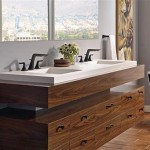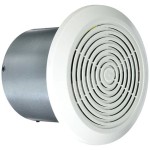Bathroom Exhaust Fan and Heater Combo: A Comprehensive Overview
The bathroom exhaust fan and heater combo is a multifaceted appliance designed to improve comfort and indoor air quality in bathrooms. This type of unit combines the functionality of a standard exhaust fan, which removes moisture and odors, with a heating element that provides supplemental warmth. Integrating these two functions into a single device can offer space-saving benefits and streamlined installation compared to installing separate units.
The primary purpose of a bathroom exhaust fan is to eliminate excess moisture generated during showering or bathing. High humidity levels in bathrooms can lead to several problems, including the growth of mold and mildew, peeling paint, and condensation on mirrors and windows. These issues can compromise the structural integrity of the building and pose health risks. The exhaust fan works by drawing moist air out of the bathroom and venting it to the exterior of the building, typically through a ductwork system.
The integrated heater component provides a source of localized warmth, which is particularly beneficial during colder months. Bathrooms often lack adequate heating from central HVAC systems, leaving them feeling chilly, especially after a shower. The heater supplements the existing heating and makes the bathroom more comfortable to use. These heaters typically employ an electric resistance heating element, similar to those found in space heaters, and are controlled by a separate switch or timer.
A bathroom exhaust fan and heater combo offers several advantages. The combination of moisture removal and supplemental heating creates a more comfortable and healthier bathroom environment. The streamlined design saves space and simplifies installation. However, there are also considerations to keep in mind, such as energy consumption and noise levels. Selecting the right unit requires careful evaluation of factors like bathroom size, ventilation requirements, and heating needs.
Understanding the Key Components
A typical bathroom exhaust fan and heater combo consists of several key components, each contributing to its overall functionality. These components include the fan motor, the heating element, the fan housing, the vent duct, and the control system.
The fan motor is responsible for driving the fan blades, which create airflow to draw air out of the bathroom. Fan motors are typically rated in cubic feet per minute (CFM), which indicates the volume of air they can move in a given time. A higher CFM rating is necessary for larger bathrooms or those with high moisture levels. The motor's efficiency and noise level are also important considerations. Some models feature energy-efficient motors that consume less power and operate more quietly.
The heating element is an electrical resistance coil that heats up when electricity passes through it. The heat generated is then dispersed into the bathroom by the fan. Heating elements are rated in watts, which indicates their power consumption and heat output. Higher wattage heaters produce more heat but also consume more electricity. Safety features, such as thermal cutoffs to prevent overheating, are typically incorporated into the design of the heating element.
The fan housing encloses the fan motor and heating element, providing structural support and protection. It is typically made of durable materials such as plastic or metal and is designed to be mounted to the ceiling or wall. The housing also helps to reduce noise levels by dampening vibrations from the fan motor.
The vent duct connects the fan housing to the exterior of the building, allowing the moist air to be exhausted outside. The duct is typically made of flexible or rigid metal and must be properly sized to ensure adequate airflow. The length and configuration of the duct can affect the fan's performance, so it is important to follow the manufacturer's recommendations for duct installation.
The control system allows the user to operate the fan and heater independently. This may consist of separate switches for the fan and heater, or a single switch with multiple settings. Some models also include a timer that automatically turns off the fan or heater after a set period. More advanced models may feature remote controls or smart home integration.
Factors to Consider When Choosing a Unit
Selecting the right bathroom exhaust fan and heater combo requires careful consideration of several factors. These include bathroom size, ventilation requirements, heating needs, noise levels, energy efficiency, and installation requirements.
Bathroom size is a crucial factor in determining the appropriate CFM rating for the exhaust fan. As a general rule, the fan should be able to exchange the air in the bathroom at least eight times per hour. This can be calculated by multiplying the bathroom's volume (length x width x height) by 0.13. For example, a bathroom that is 8 feet long, 5 feet wide, and 8 feet high has a volume of 320 cubic feet. Multiplying 320 by 0.13 yields a CFM rating of approximately 42. A fan with a CFM rating of at least 42 would be suitable for this bathroom.
Ventilation requirements also depend on the bathroom's usage. Bathrooms that are used frequently or have high moisture levels may require a higher CFM rating. Consider the number of people who use the bathroom and the frequency of showers or baths. Bathrooms with whirlpool tubs or steam showers may require even higher CFM ratings to effectively remove excess moisture.
Heating needs depend on the climate and the user's personal preferences. Consider the average temperature in the bathroom during the winter months and the desired level of warmth. The wattage of the heater should be sufficient to raise the bathroom's temperature to a comfortable level. It is important to avoid over-sizing the heater, as this can lead to excessive energy consumption.
Noise levels are an important consideration, especially for bedrooms or other quiet areas. Fan noise is measured in sones, with lower sone ratings indicating quieter operation. Look for models with sone ratings of 1.0 or less for quiet operation. Some models feature innovative fan designs or sound-dampening materials that reduce noise levels.
Energy efficiency is becoming increasingly important as energy costs rise. Look for models with energy-efficient motors and heating elements. Energy Star-certified models meet strict energy efficiency guidelines and can save money on utility bills. Consider models with timers or occupancy sensors that automatically turn off the fan and heater when they are not needed.
Installation requirements can vary depending on the model and the existing wiring in the bathroom. Some models are designed for DIY installation, while others require professional installation. Consider the complexity of the installation process and your level of experience before purchasing a unit. Ensure that the electrical wiring in the bathroom is adequate to handle the power requirements of the fan and heater.
Installation and Maintenance
Proper installation and regular maintenance are essential for ensuring the optimal performance and longevity of a bathroom exhaust fan and heater combo. Incorrect installation can lead to reduced airflow, increased noise levels, and potential safety hazards. Regular maintenance, such as cleaning the fan blades and motor, can prevent dust buildup and ensure efficient operation.
Before beginning the installation process, it is important to turn off the power to the bathroom at the circuit breaker. This will prevent electrical shock during the installation. Carefully read and follow the manufacturer's instructions for installation. Ensure that the fan housing is securely mounted to the ceiling or wall and that the vent duct is properly connected.
The vent duct should be as short and straight as possible to minimize airflow resistance. Avoid sharp bends or kinks in the duct, as these can significantly reduce the fan's performance. Insulate the vent duct to prevent condensation and heat loss. The duct should terminate outside the building in a location that is away from windows, doors, and vents to prevent the re-entry of moist air.
Connect the electrical wiring according to the manufacturer's instructions and local electrical codes. Ensure that all connections are secure and properly insulated. Use wire connectors that are rated for the amperage of the fan and heater. If you are not comfortable working with electrical wiring, it is best to hire a qualified electrician to perform the installation.
After the installation is complete, test the fan and heater to ensure that they are operating properly. Check for any unusual noises or vibrations. Verify that the fan is effectively removing moisture from the bathroom and that the heater is providing adequate warmth.
Regular maintenance is essential for maintaining the performance and longevity of the unit. Clean the fan blades and motor at least once a year to remove dust and debris. Use a vacuum cleaner or a soft brush to remove dust from the fan blades and motor housing. Lubricate the fan motor if necessary. Check the vent duct for any obstructions or damage. Replace the vent duct if it is damaged or clogged.
By carefully considering these factors and following the manufacturer's instructions, homeowners can select and install a bathroom exhaust fan and heater combo that effectively removes moisture, provides supplemental warmth, and creates a more comfortable and healthier bathroom environment.

Whisper Cozy Fan Heater Combo 80 110 Cfm Panasonic North America United States

Bhfled80 Powerheat Bathroom Exhaust Fan Heater And Led Light Combination 80 C

Should I Install A Bathroom Heater Fan Light Combo

Broan Nutone Powerheat Series 110 Cfm Ceiling Bathroom Exhaust Fan With Heater And Cct Led Lighting Bhfled110 The Home

Broan Powerheat 2 Sone 110 Cfm Bright White Lighted Bathroom Fan And Heater Bhfled110 At Com

Utilitech Heater 1 5 Sone 80 Cfm White Lighted Bathroom Fan And 7123 02 L At Com

Clipsal Airflow 6600ads We 3 In 1 Bathroom Heater Lamp Light Exhaust Fan 2 Heat White

Nutone Qt9093wh Bathroom 110 Cfm Vent Combination Fan Heater Light Nig Faucetlist Com
Bath Fan Light Heaters Hein Electric

Broan Nutone 110 Cfm Ceiling Bathroom Exhaust Fan With Light And 1500 Watt Heater 765h110l The Home







